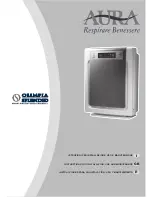
1.8 Checks to the refrigeration equipment
Where electrical components are being changed, they shall be fit for the
purpose and to the correct specification. At all times the manufacturer’s mainte-
nance and service guidelines shall be followed. If in doubt consult the manufac-
turer’s technical department for assistance.The following checks shall be applied
to installations using flammable refrigerants: the charge size is in accordance
with the room size within which the refrigerant containing parts are installed; the
ventilation machinery and outlets are operating adequately and are not obstruct-
ed; if an indirect refrigerating circuit is being used, the secondary circuit shall be
checked for the presence of refrigerant; marking to the equipment continues to
be visible and legible. Markings and signs that
are illegible shall be corrected; refrigeration pipe or components are installed in
a position where they are unlikely to be exposed to any substance which may
corrode refrigerant containing compo
nents, unless the components are constructed of materials which are inherently
resistant to being corroded or are suitably protected against being so corroded.
1.9 Checks to electrical devices
Repair and maintenance to electrical components shall include initial safety
checks and component inspection procedures. If a fault exists that could com-
promise safety, then no electrical supply shall be connected to the circuit until it
is satisfactorily dealt with. If the fault cannot be corrected immediately but it is
necessary to continue operation, an adequate temporary solution shall be used.
This shall be reported to the owner of the equipment so all parties are advised.
Initial safety checks shall include: that capacitors are discharged: this shall be
done in a safe manner to avoid possibility of sparking; that there no live electri-
cal components and wiring are exposed while charging, recovering or purging
the system; that there is continuity of earth bonding.
2 REPAIRS TO SEALED COMPONENTS
2.1
During repairs to sealed components, all electrical supplies shall be discon-
nected from the equipment being worked upon prior to any removal of
6
sealed covers, etc. If it is absolutely necessary to have an electrical supply to
equipment during servicing, then a permanently operating form of leak detec-
tion shall be located at the most critical point to warn of a potentially hazardous
situation.
2.2
Particular attention shall be paid to the following to ensure that by working
on electrical components, the casing is not altered in such a way that the level
of protection is affected. This shall include damage to cables, excessive
number of connections, terminals not made to original specification, damage to
seals, incorrect fitting of glands, etc. Ensure that apparatus is mounted secure-
ly. Ensure that seals or sealing materials have not degraded such that they no
longer serve the purpose of preventing the ingress of flammable atmospheres.
Replacement parts shall be in accordance with the manufacturer’s specifica-
tions.
NOTE:
The use of silicon sealant may inhibit the effectiveness of some types of
leak detection equipment. Intrinsically safe components do not have to be
isolated prior to working on them.
3 REPAIR TO INTRINSICALLY SAFE COMPONENTS
Do not apply any permanent inductive or capacitance loads to the circuit
without ensuring that this will not exceed the permissible voltage and current
permitted for the equipment in use.
Intrinsically safe components are the only types that can be worked on while
live in the presence of a flammable atmosphere. The test apparatus shall be at
the correct rating. Replace components only with parts specified by the manu-
facturer. Other parts may result in the ignition of refrigerant in the atmosphere
from a leak.
4 CABLING
Check that cabling will not be subject to wear, corrosion, excessive pressure,
vibration, sharp edges or any other adverse environmental effects. The check
shall also take into account the effects of aging or continual vibration from
sources such as compressors or fans.
7
































